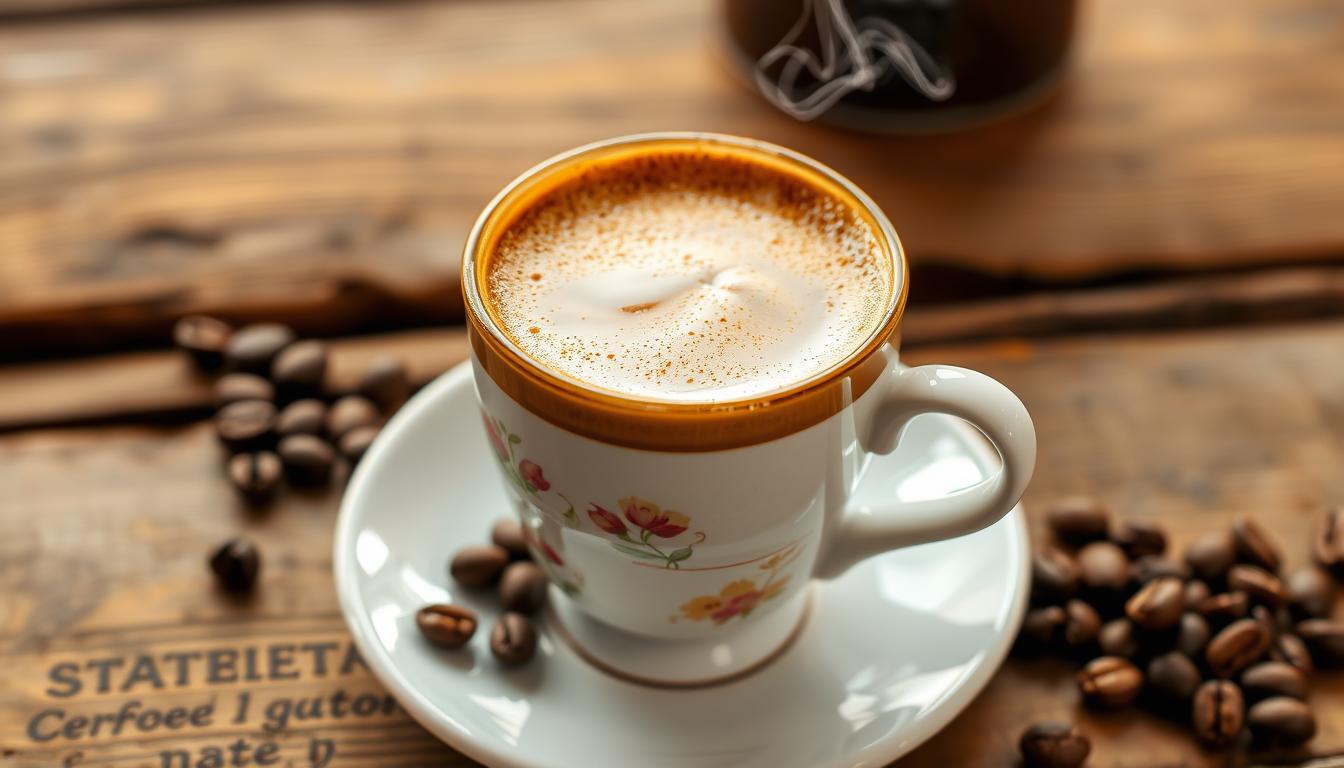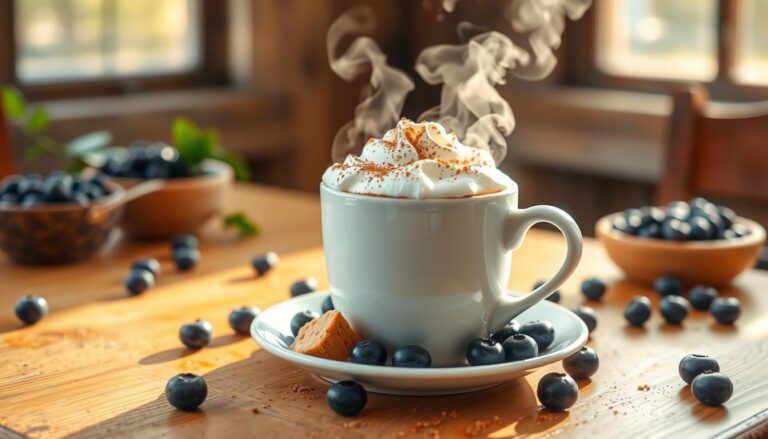If you love coffee, you might wonder if lattes are better hot or cold. The answer is simple: lattes can be both. It really depends on what you like and the season. Knowing the difference between hot and cold lattes can help you choose the perfect coffee for you.
Key Takeaways
- Lattes can be served hot or cold, depending on personal preference and seasonal factors.
- Traditionally, lattes are hot beverages made with espresso and steamed milk, typically served between 150°F and 165°F.
- Iced lattes are a popular variation, enjoyed during warmer months, and served over ice.
- The ratio of espresso to milk in a latte is typically 1:3, with a thin layer of foam on top.
- Espresso is a key component in lattes, providing a concentrated caffeine boost and robust flavor.
the Basics of a Latte
A latte is a mix of espresso, steamed milk, and foam. It’s a favorite among coffee lovers. It has a smooth texture and a rich flavor.
The Essential Latte Components
The three main parts of a latte are:
- Espresso: A strong coffee made by pushing hot water through coffee grounds.
- Steamed milk: Milk that’s been heated and made smooth.
- Foam: A light topping made from the steamed milk.
Traditional Latte Ratios
The classic latte mix is 1 part espresso to 3 parts milk. This mix gives a good balance of coffee and creaminess. But, you can adjust it to your liking. Some places offer different latte sizes for everyone.
The Role of Espresso in Lattes
Espresso is the base of a latte, adding a strong coffee taste. The best brewing temperature is between 190°F and 200°F. Each shot has 30 to 50 milligrams of caffeine, making the latte energizing.
“A well-crafted latte is a true work of art, where the interplay of espresso, steamed milk, and foam creates a harmonious and delightful experience for the senses.”
Is a Latte Hot or Cold: Understanding Temperature Options
Lattes can be enjoyed hot or cold. The traditional latte is hot, with a temperature between 150°F and 165°F. This temperature is perfect for balancing flavors and texture.
The hot latte is made with espresso and steamed milk. It’s rich, creamy, and aromatic.
Iced lattes are popular in warm weather. They’re made by pouring chilled espresso over ice and adding cold milk. This version is refreshing and gives a cool caffeine boost.
Choosing between hot and iced lattes depends on your mood and the weather. Both have the same coffee and milk, but at different temperatures. You can enjoy a warm or cool latte, depending on your preference.
“Consistent milk temperature is key for a great cup of coffee. The ideal milk temperature for coffee is between 140°F and 160°F (60°C and 70°C).”
To enjoy your latte at the best temperature, get a contactless digital coffee milk thermometer. It lets you measure milk temperature precisely. This ensures your coffee is always perfectly steamed.
The Perfect Temperature for Hot Lattes
Making the perfect hot latte needs careful attention to temperature. The best temperature for a great hot espresso drink is between 150°F and 165°F. This range makes sure the espresso flavor is balanced, the milk froth is creamy, and the drink is enjoyable.
Ideal Espresso Temperature Range
To get this perfect latte temperature, the espresso should be brewed between 190°F and 200°F. This range is perfect for extracting the coffee’s unique flavors and aromas. It results in a rich, balanced shot of espresso that’s the base of a great latte.
Optimal Milk Steaming Temperature
The milk’s temperature is also key in a latte. It should be steamed to 135°F to 150°F, with 140°F being ideal. At this temperature, the milk’s sugars are activated, making a sweet and creamy froth that goes well with the espresso.
Maintaining Latte Heat
To keep your hot latte warm, try a few tricks. Preheat the cup, add a thick layer of milk froth, and use an insulated mug or tumbler. Ordering an “extra-hot” latte can also help, but it might affect the flavor.

Getting the ideal temperature for a hot latte is a fine balance. But with the right techniques and attention, you can enjoy a perfectly made espresso drink every time.
Exploring Iced Latte Variations
Iced lattes are a hit in summer, a cool change from hot lattes. They mix espresso, cold milk, and ice for a refreshing drink. It’s perfect for when it’s hot outside.
There’s no one “right” temperature for iced lattes. It depends on what you like. Some like them very cold, while others prefer a bit warmer.
To make an iced latte, baristas pour espresso over ice in a glass. Then, they add cold milk. Some also stir the espresso with ice before adding milk foam on top. This keeps the drink cold longer.
Coffee shops also offer flavored iced lattes. You can find vanilla, caramel, and seasonal flavors like pumpkin spice. These add a sweet twist to the usual iced coffee.

According to recent data, the cold brew coffee market is projected to reach $1.37 billion by 2027, indicating the growing popularity of chilled coffee beverages.
Whether you like the classic or a flavored iced latte, it’s a great choice. It’s refreshing, caffeinated, and perfect for hot days.
Comparing Hot vs Iced Latte Preparation Methods
Choosing how to make your latte can change everything. Do you like a warm, frothy hot latte or a cool iced one? Knowing the differences can help you get the taste and feel you want.
Hot Latte Making Process
Making a hot latte means mixing espresso with steamed milk and foam. The secret is in steaming the milk right. It should be silky and match the espresso’s strong taste. The milk’s temperature, between 150°F and 160°F, is key for the perfect mix of creaminess and warmth.
Iced Latte Techniques
To make an iced latte, start by pouring espresso over ice. The ice keeps the espresso’s flavor and smell fresh. Then, add cold milk for a creamy drink. The espresso and milk mix is important, with about one-third espresso to two-thirds milk.
Equipment Considerations
An espresso machine is best for both hot and iced lattes. It controls pressure and temperature for the perfect espresso. But, if you don’t have one, coffee concentrate can work too. Mix it with milk and ice for a homemade iced latte.
“The secret to a great latte lies in the balance of espresso, milk, and temperature – whether you prefer it hot or iced.”
Whether you like hot or iced lattes, it’s all about what you enjoy most. Learning about the different ways to make them and what you need can help you enjoy your favorite coffee drink even more.
Different Types of Milk and Their Impact on Latte Quality
The type of milk you choose is key to a great latte. Each milk type, from whole to non-dairy, brings its own flavor and texture. This greatly affects your latte’s quality.
Whole milk is a favorite among baristas. It makes a latte rich and creamy, perfect for latte art. Skim milk, with less fat, creates a denser foam. This foam is harder to shape for detailed designs.
Non-dairy milks offer different results. Oat milk steams well and froths perfectly, but it can taste nutty. Almond milk makes a watery latte with less flavor. Soy milk struggles with frothing and taste, often tasting bland.
Lactaid (whole) milk surprised everyone with its great steam and taste. Macadamia nut milk also impressed, scoring high for taste and performance. It’s a great choice for milk-based espresso drinks.
The Specialty Coffee Association suggests heating steamed milk to 55–65°C (131–149°F) for the best latte. Getting the right microfoam for latte art takes practice. Swirling the milk after aeration helps mix the foam with the liquid.
“The type of milk used significantly affects latte flavor and texture. Whole milk creates a richer, creamier latte, while skim milk results in a lighter taste.”
Conclusion
Lattes are great because you can have them hot or cold. You might like the warm feeling of a hot latte or the cool taste of an iced one. This lets you pick what you like best, depending on the season.
The quality of a latte comes from a few key things. These include the right espresso brewing temperature, how well the milk is steamed, and the mix of ingredients. Knowing how to make a latte well means you can enjoy it anywhere, whether it’s at a coffee shop or at home.
Lattes are very popular in the coffee world. You can make them your own by choosing different milks, adding syrups, and using toppings. As you try out different lattes, you’ll find the perfect mix of flavors and temperatures that you love.







